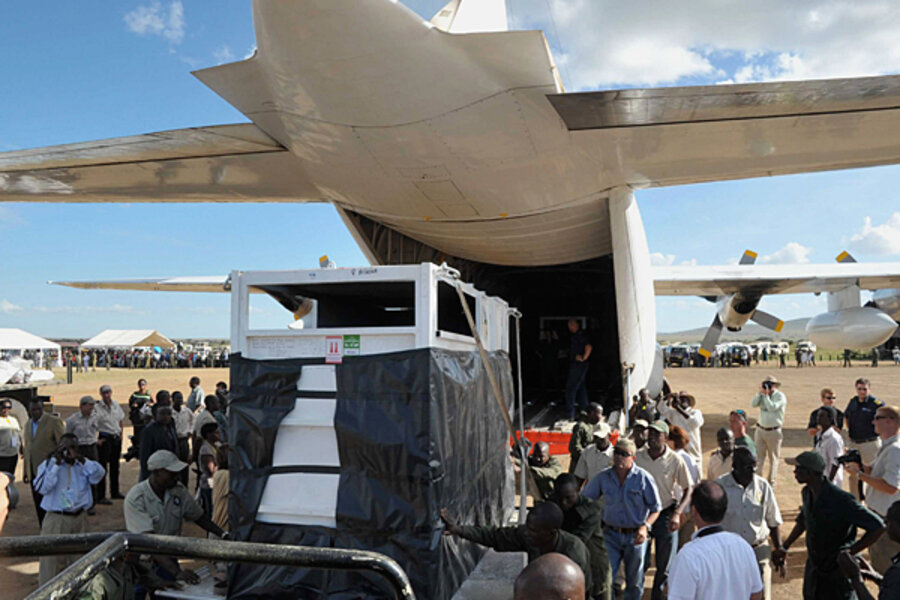After half-century absence, Black Rhinos fly home to Serengeti
Loading...
| Serengeti National Reserve, Tanzania
As is often the case at an African VIP function, the honored guests were a little late.
But finally, the huge Hercules cargo airplane, 90 minutes behind schedule, lumbered to a halt in a cloud of dust at the end of the dirt airstrip in Tanzania's Serengeti National Reserve.
On board were five critically endangered Eastern Black Rhinos, being returned to their native Tanzania nearly half a century after their ancestors were evacuated to save them from poachers.
The reason for the delay? One of the six originally slated for Friday’s repatriation was found to have a suspected eye infection, and was left behind in South Africa on vet’s orders.
That did not dampen spirits among the 500-strong crowd who gathered under a fierce sun in the middle of the Serengeti National Reserve to watch what many call "the most ambitious wildlife relocation in 50 years.”
Brass bands and plume headdresses
To the left, beside the Tanzanian National Parks Authority Brass Band, warriors dressed in serval cat and Colobus monkey skins, with ostrich plume headdresses, performed traditional welcoming dances.
Diplomats sweated in suits, journalists jostled for interviews, and chefs struggled to keep the buffet "almost ready" for an extra two hours. But, as Simon Mduma, director of the Tanzanian Wildlife Research Institute said, “this is a historic day.”
The five Eastern Black Rhinos are the first of 32 of the critically endangered species to be flown from a private game park in South Africa to this vast wildlife ecosystem in northern Tanzania.
Mr. Mduma – and many others – have said it is the largest relocation of large mammals over such a distance.
Takeoff to touch down was a little over 1,700 miles as the crow – or rhino – flies.
Capturing the rhinos
The operation began six weeks ago, when Piet Morkel, a veterinarian and rhino expert who has darted more than 1,000 of the animals worldwide, captured the first of the 32 in their South African conservancy.
Since then, they have been kept in large specially-constructed pens called bomas.
Two handlers have been with them the whole time and have familiarized them with enclosed spaces, steadily introducing them to the crates used during the flight, and slowly changing their fodder to that found in East Africa.
Early on Friday, each of the 1.2-ton animals was ushered into their crates and loaded onto the Hercules. Five hours later, those crates were slowly edged out of the cavernous belly of the cargo hold and onto waiting trucks to be driven to their new home.
The five rhinos will be kept in new bomas for the next three to four weeks, and then released into a 15-square-mile enclosure ringed with electric fences. Once they are fully acclimatized, they will be introduced fully into the wild.
“That’s going to take about a year,” said Brian Harris, managing director of the Singita Grumeti Fund, a private conservation foundation bankrolled by Wall Street financier Paul Tudor-Jones, which paid the relocation’s $6.8 million cost. “We need to keep a close eye on them as they live through a wet season, to build up resistance to the tsetse fly [which carries sleeping sickness], and a dry season, so they learn how to find water.”
But the threat that forced their ancestors from this land has not gone away, even if it has diminished.
Poaching
Poaching driven by increased demand for ivory in the Far East has again increased in Africa in the past five years.
Six black rhinos were killed for their horns in neighboring Kenya in the past 12 months, and efforts have been put in place to avoid the same thing happening to Tanzania’s new arrivals.
“This event is a stark reminder of what went wrong in the past, and what needs to be done to prevent that happening again in the future,” said Tanzanian President Jakaya Kikwete.
The reason that the Eastern Black Rhino ended up in South Africa, far from their natural habitat, was because conservationists shifted seven for their own safety in 1964, as decades of wildlife slaughter began across east and central Africa.
By 1991, only two black rhinos remained in the Serengeti, down from more than 700 in the mid-1970s.
Numbers have edged back up to 33 – to be doubled with the current repatriation – but the snare-setting, tusk-hacking, and horn hunting still goes on today.
An elite force of 24 rangers have been specially trained to monitor the new Serengeti rhinos, which will have GPS chips inserted in their horns so conservationists can track them.
“If someone in the local community is going to be offered thousands of dollars to go out there and get a rhino horn, of course it’s going to be difficult to stop that,” said Dennis Rentsch, technical adviser for Frankfurt Zoological Society, which oversaw the repatriation. “But also if we can find ways for people to earn a living without having to come into the park to poach game meat, then there’s less chance they will ever come across a rhino.”
The ultimate aim, said the Singita Grumeti Fund’s Mr. Harris, is to rebuild the biodiversity of the Serengeti ecosystem. “Reintroducing the rhinos and ensuring their safety from poachers will automatically protect other species sharing the same habitat. So more animals will feel comfortable here and more will come in, allowing natural processes to function and restore the environment.”
Related:





